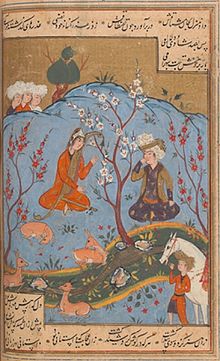


Hasht Bihisht (Persian: هشت بهشت, lit. 'Eight Paradises') is a collection of speeches authored by Amir Khusraw around 1302. The poem is based on the Haft Paykar by Nizami, written around 1197, which in turn takes its outline from the earlier epic Shahnameh written by Firdausi around 1010. Like Nizami's Haft Paykar, Khusraw's Hasht Bihisht uses a legend about Bahram V Gur as its frame story and, in the style of One Thousand and One Nights, introduces folktales told by seven princesses. Most famously, Khusraw appears to be the first writer to have added The Three Princes of Serendip as characters and the story of the alleged camel theft and recovery.
The eight "paradises" in the poem link closely with the Islamic conception of Heaven with its eight gates and eight spaces, each one decorated with a special precious stone or material. Seven of the eight paradises are pavilions constructed for Bahram's "therapy" of storytelling. There is also a link to the architectural and garden plan of eight paradises.
The narrative
The narrative commences with the story of Bahram and Dilaram.
Later, Bahram has seven differently-coloured domed pavilions built for him within his palace grounds, in which wait seven princesses from various parts of the world. Bahram Gur visits each on a different day of the week and each of them tells him a story:
- Saturday – the Black Pavilion – the Indian Princess (The Tale of the Three Princes of Serendip)
- Sunday – the Yellow Pavilion – the Princess of Nimruz
- Monday – the Green Pavilion – the Slav Princess
- Tuesday – the Red Pavilion – the Tatar Princess
- Wednesday – the Violet Pavilion – the Princess of Rum
- Thursday – the Brown Pavilion – the Arabian Princess
- Friday – the White Pavilion – the Princess of Khwarezm
Manuscripts
The Hasht Bihisht, and indeed the whole of the Khamsah, was a popular work in the centuries after Khusraw's death, not only in India, but in Iran and the Ottoman Empire, and as such was illustrated nearly as frequently as Nizami's Khamsah from the early fifteenth century on.
Translations
- The Hasht Bihisht has never been translated entirely into any language except Russian and Italian. Verse translations of two stories (Tuesday and Friday) by Sunil Sharma have been published.
- Lal and Prasada provide a partial direct-to-English translation and commentary of Saturday's tale which introduces The Three Princes of Serendip.
Walters Art Museum manuscript W.623
An illustrated and illuminated manuscript of the poem was part of a Khamsah from 1609 CE produced in Safavid Iran. All texts are written in black nastaʿlīq script with chapter headings in red.
-
 Bahram Gur recognizes Dilaram by the music with which she enchants the animals
Bahram Gur recognizes Dilaram by the music with which she enchants the animals
-
 Bahram Gur in the red pavilion
Bahram Gur in the red pavilion
-
 Bahram Gur in the brown pavilion
Bahram Gur in the brown pavilion
Walters Art Museum manuscript W.624
The poem was illustrated in a manuscript probably produced in Lahore in the late sixteenth CE which is associated with the patronage of Akbar (r. 1556 – 1605 CE).
The manuscript was written in nasta'liq script by one of the greatest calligraphers of the Mughal atelier, Muhammad Husayn al-Kashmiri, honoured with the epithet Zarrin Qalam (golden pen). The manuscript has the names of a number of painters: Lal, Manuhar, Sanwalah, Farrukh, Aliquli, Dharamdas, Narsing, Jagannath, Miskina, Mukund, and Surdas Gujarati. The illuminators are Husayn Naqqash, Mansur Naqqash, Khvajah Jan Shirazi, and Lutf Allah Muzahhib
-
 The princesses of the seven pavilions bow in homage to Bahram Gur.
The princesses of the seven pavilions bow in homage to Bahram Gur.
-
 The tale told by the princess of the Yellow Pavilion. Hassan the goldsmith descending from imprisonment in a tower, as his wife goes up to imprisonment.
The tale told by the princess of the Yellow Pavilion. Hassan the goldsmith descending from imprisonment in a tower, as his wife goes up to imprisonment.
-
 The Story of the Princess of the Blue Pavilion, Metropolitan Museum of Art
The Story of the Princess of the Blue Pavilion, Metropolitan Museum of Art
-
 Bahram Gur visiting the Princess of Arabia in the Brown Pavilion
Bahram Gur visiting the Princess of Arabia in the Brown Pavilion
-
 The story of the Princess of Khwarezm in the White Pavilion.
The story of the Princess of Khwarezm in the White Pavilion.
References
- ^ "Encyclopaedia Iranica entry on Hast Behest". Iranicaonline.org. Retrieved 2013-03-24.
- Brend, Barbara (2002). Perspectives on Persian painting : illustrations to Amir Khusrau's Khamsah. New York: Routledge. pp. 25–34. ISBN 978-0-7007-1467-4.
- Gabbay, Alyssa (2009). Islamic tolerance : Amir Khusraw and pluralism (1. publ. ed.). London: Routledge. p. 43. ISBN 978-0-415-77913-5.
- Sharma, Sunil (2005). Amir Khusraw: The Poet of Sultans and Sufis. Makers of the Muslim World. Oneworld Publications. ISBN 9781851683628.
- Lal, Oudh Behari; Prasada, Jwala (1896). Complete Key to the Persian Entrance Course for 1897-1898 (for the University of Allahabad) (in English, Arabic, and Urdu). Allahabad, India: Ram Chandra.
- "Walters Art Museum Ms. W.623 on". Flickr.com. Retrieved 2013-03-24.
- "The Walters Art Museum set for the manuscript on". Flickr.com. Retrieved 2013-03-24.
- "Description page at". Thedigitalwalters.org. Retrieved 2013-03-24.
- The image page at metmuseum.org